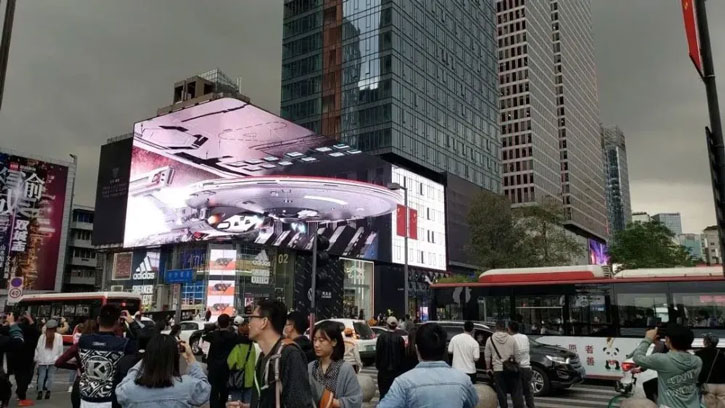In May 2020, the animation effect of “Ocean Wave Fish Tank” appeared in a low-key manner in the SM Building in South Korea, which leads to the naked-eye 3D LED display fire cut in again. This artwork named Wave was tailored by the Korean creative company district for the curved display screen of the SMTown building. The size, with the fake and real visual effects, and the simulated sound of the waves, people can’t help but worry that the waves will really break through the glass and drown the city.
On October 1 of the same year, on the occasion of the National Day holiday, the “naked eye 3D spaceship” on Chunxi Road, Taikoo Li, Chengdu was launched, and then large naked eye 3D screens appeared one after another across the country, quickly plundering the facades of major commercial buildings.

In fact, 3D naked-eye technology is not a new product. A few years ago, Sharp, HTC, and many other manufacturers launched products equipped with naked-eye 3D display technology on electronic products, but they did not set off a big wave at that time. , the current explosion of 3D screens is mostly a phenomenon that emerged because of the investment in marketing expenses.
Its sustainability often depends on the cost of promotion and marketing. This is the same as most of the current Internet celebrities. It is very good to be popular for 1–2 years. Most of Internet celebrities often don’t last for a year. Because once the marketing company has a new goal or idea, it is replaced, and then there is no news.
The realization principle of 3D LED technology
3D naked-eye technology is actually not mysterious, it is essentially the use of human parallax characteristics. The distance between the eyes of the human eye is about 6cm. When we are looking at an object, the two eyes look at the left and right viewpoints respectively. The images seen by the two eyes are slightly different. When they are superimposed together, the brain defaults to them. Should overlap and be clear, this binocular parallax gives us a sense of depth and space.
3D screens take advantage of this feature, with a screen made up of opaque layers and a series of precisely spaced slits that allow the viewer to see different pixels in both eyes.
This feature is doomed to its shortcomings, the viewer must be in the correct position to experience the 3D immersion effect. Therefore, most of the naked-eye 3D screens that have exploded in recent years are composed of two faces with different angles. The front of the two screen corners can see the side and front of the object at the same time. With the animation material of a specific perspective, the false frame set in the animation, creates a strong sense of the scene.
Here I have to talk about the slightly deeper principle of the 3D LED display, which will be more conducive to our understanding of the 3D concept. First, imagine such a 3D display device, which can solve the current passive 3D display mode. Displays the problem of halving the screen resolution.
In order to achieve the above purpose, we try to invent a technical solution to solve this problem. Here we can provide a 3D display device, including an LED display, a magnetic field device and a signal module. The magnetic field device is arranged in front of the light-emitting surface of the display screen, and the magnetic field device and the signal module can be directly connected;
When the signal module provides a changing current signal to the magnetic field device, the magnetic field device will generate a changing magnetic field corresponding to the adjacent changing current signal, and the changing frequency of the magnetic field is synchronized with the refresh frequency. The left and right eyes of the LED display.
The direction of the rotation of the magnetic field reaches the polarization plane to activate the linearly polarized light emitted by the LED display so that the direction of the polarization plane of the rotated linearly polarized light is parallel to the direction of the polarization plane of the linearly polarized light before the rotation and perpendicular to the direction before the rotation. The direction of the plane of polarization of linearly polarized light. Switches back and forth between the orientations of the plane of polarization of linearly polarized light.
In another aspect, a working method of a 3D display device is provided, comprising a signal module for providing a changing current signal to a magnetic field device. The magnetic field device generates a changing magnetic field according to the changing current signal, and the changing frequency of the magnetic field is consistent with the LED display. The refresh frequency of the left and right eyes of the screen is synchronized to form a 3D display screen effect.
Therefore, some seemingly stunning display effects are behind countless technical polishing and strong product support. Through this slightly in-depth 3D principle, we have a further understanding of the display of 3D LED technology.
Generally speaking, the principle of 3D glasses-free technology is not complicated, but it is not enough to be so popular because of its brilliant visual presentation and marketing promotion. The real reason may have to be traced from the media.
When people receive information, they need to go through a medium, which is generally divided into two types—physical medium and non-physical medium.
From the paintings painted by primitive people on the walls of caves to today’s prints, these stable solid entities are called physical media, while the opposite non-physical media are mainly digital media. The biggest difference between hand-painted and board-painted is not just the change of painting tools, but the replacement of physical “atoms” by virtual digital “bits” as new materials and tools.
The occupation of the opposite of the 3D screen just shows the aggression of digital media toward physical media. From independent building facades to 2D screens to 3D screens, from two-dimensional plane to three-dimensional, we are moving towards an era of faster and faster information transmission.
When receiving information, traditional media requires us to mobilize our five senses and imagination, and sensory mobilization and thought transmission finally complete the process of receiving information. The three-dimensional digital media is different, and people’s associations with information are weakened.
Because three-dimensional people live in four-dimensional three-dimensional space (including the time dimension), people perceive the world as three-dimensional mainly through vision and body, including appearance textures such as color, material, luster, as well as the intricate internal structure and space-time dynamic Kinetic relationships, which lead to any of our primal impulses to discover and create about the world are three-dimensional.
Three-dimensional people hardly need to think to understand three-dimensional scenes and mobilize primitive and direct emotions. Compared with two-dimensional, the missing dimension seems to remind us all the time that this is the virtual content presented by the screen. Therefore, 3D media can connect the real world and the virtual world, which is impossible for 2D media. This is also the main reason for the explosion of naked-eye 3D LED displays.
Technology is just a carrier of the medium, it is just a container. It is not necessarily this technology that is pursued and needed. More appropriately, we need experience, and the 3D naked-eye screen provides this experience – the non-daily in the every day, the unreal in the real.






